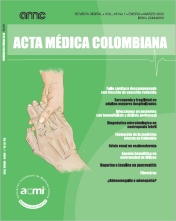Hemolytic anemia as an initial presentation of Wilson's disease
About a rare disease with an infrequent presentation
Abstract
Wilson's disease is a rare genetic disorder that affects the excretion capacity of copper. Its distribution is worldwide, with an estimated prevalence in 30 cases per million habitants. Although the most frequent symptoms are those of hepatic and neuropsychiatric origin, hemolytic anemia with negative Coombs may be the only manifestation of the disease and its presentation usually precedes for months to clinically evident liver disease or neurological manifestations. The case of a young patient with negative Coombs hemolytic anemia and an alkaline phosphatase / total bilirubin ratio <4 and AST / ALT> 2.2 is presented, establishing Wilson's disease as a diagnosis.
Metrics
Acta Medica Colombiana uses the CC-BY 4.0 license. Authors retain all rights over their work.


